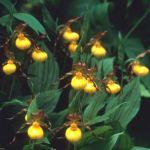| Common Name: |
Bleeding Heart |
| Other Names: |
American Valerian, Greater Yellow Lady's Slipper, Lady's Slipper, Nerve Root, Slipper Root, Venus Shoe, Yellow Lady's Slipper |
| Botanical Name: |
Cypripedium parviflorum var. pubescens syn. C. calceolus var. pubescens, C. pubescens var. pubescens. |
| Genus: |
Cypripedium |
| Family: |
Orchidaceae |
| Native Location: |
N America |
| Cultivation: |
Rich soil in an open, shady situation. |
| Propagation: |
By division in spring; commercially, by seed sown under sterile laboratory conditions. |
| Harvest: |
Rhizomes are lifted in autumn and dried for infusions, liquid extracts, powder, and tinctures. |
| Height: |
30-60cm (12-24in) |
| Width: |
23-40cm (9-16in) |
| Hardiness: |
Z3-8 |
| Parts Used: |
Root, Rhizomes |
| Chemical Constituents: |
Resin
Tannins
Volatile Acid
Volatile Oils
|
| Properties: |
A pungent, bitter-sweet herb, with an unpleasant odor, similar to that of Valeriana officanilis (See, Common valerian). It relieves spasms and has sedative and tonic effects on the nervous system. |
| Medicinal Uses: |
Internally for anxiety, nervous tension, insomnia, depression and tension headaches. Often combined with Avena sativa (See, oats) and Scutellaria lateriflora (See, Virginia scullcap) for anxiety.
To treat nervousness, emotional tension, insomnia, diarrhea, and menstrual difficulties. |
| Known Effects: |
Irritates mucous membranes
Stimulates gastrointestinal tract
Increases perspiration
Miscellaneous Information:
Hairs on stems and leaves irritate body when touched
May produce skin eruptions similar to those caused by poison ivy
|
| Possible Additional Effects: |
Potential sedative to treat anxiety or restlessness
May increase perspiration
May help extract gas from intestinal tract
May relieve spasm in skeletal or smooth muscle
|
| Typical Dose: |
A typical dose of nerve root may range from 2 to 4 gm of the dried root/rhizome mixed with 150 ml of boiling water, steeped for five to ten minutes and taken as a tea three times a day. |
| Possible Side Effects: |
Nerve Root's side effects include hallucinations, restlessness, headache, and giddiness. |
| Drug Interactions: |
| Taking nerve root with these drugs may increase the risk of excessive sedation and mental depression and impairment: |
| Alprazolam, (Apo-Alpraz, Xanax) |
Amitriptyline, (Elavil, Levate) |
Amoxapine, (Asendin) |
| Bupropion, (Wellbutrin, Zyban) |
Buspirone, (BuSpar, Nu-Buspirone) |
Clonazepam, (Klonopin, Rivotril) |
| Cyclobenzaprine, (Flexiril, Novo-Cycloprine) |
Desipramine, (Alti-Desipramine, Norpramin) |
Diazepam, (Apo-Diazepam, Valium) |
| Diphenhydramine, (Benadryl Allergy, Nytol) |
Doxepin, (Sinequan, Zonalon) |
Fluoxetine, (Prozac, Sarafem) |
| Fluphenazine, (Modecate, Prolixin) |
Flurazepam, (Apo-Flurazepam, Dalmane) |
Imipramine, (Apo-Imipramine, Tofranil) |
| Lorazepam, (Ativan, Nu-Loraz) |
Metoclopramide, (Apo-Metoclop, Reglan) |
Midazolam, (Apo-Midazolam, Versed) |
| Morphine Hydrochloride, (Morphine Hydrochloride) |
Morphine Sulfate, (Kadian, MS Contin) |
Nefazodone, (Serzone) |
| Nortriptyline, (Aventyl HCl, Pamelor) |
Olanzapine, (Zydis, Zyprexa) |
Oxazepam, (Novoxapam, Serax) |
| Oxcarbazepine, (Trileptal) |
Prochlorperazine, (Compazine, Compro) |
Propoxyphene, (Darvon, Darvon-N) |
| Quetiapine, (Seroquel) |
Risperidone, (Risperdal) |
Temazepam, (Novo-Temazepam, Restoril) |
| Tramadol, (Ultram) |
Triazolam, (Apo-Triazo, Halcion) |
Zolpidem, (Ambien) |
|
| Warnings and Precautions: |
Handling lady's slipper orchids may cause an allergic reaction.
Don't take if you:
Are pregnant, think you may be pregnant, or plan pregnancy in the near future.
Have any chronic disease of the gastrointestinal tract, such as stomach or duodenal ulcers, reflux esophagitis, ulcerative colitis, spastic colitis, diverticulosis, or diverticulitis
Consult your doctor if you:
Take this herb for any medical problem that doesn't improve in 2 weeks (There may be safer, more effective treatments)
Take any medicinal drugs or herbs containing aspirin, laxatives, cold and cough remedies, antacids, vitamins, minerals, amino acids, supplements, other prescription or non-prescription drugs
Pregnancy:
Don't use unless prescribed by your doctor.
Breastfeeding:
Don't use unless prescribed by your doctor.
Infants and Children:
Treating infants and children under 2 with any herbal preparation is hazardous.
Others:
None are expected if you are beyond childhood, under 45, not pregnant, basically healthy, take it only for a short time and do not exceed manufacturer's recommended dose.
Storage:
Store in a cool, dry area away from direct light, but don't freeze.
Store safely out of reach of children.
Don't store in bathroom medicine cabinet. Heat and moisture may change the action of the herb.
Safe Dosage:
Consult your doctor for the appropriate dose for your condition.
|
| Toxicity: |
Rated relatively safe when taken in appropriate quantities for short periods of time. |
| Adverse Reactions, Side Effects, or Overdose Symptoms: |
| Signs and Symptoms |
What To Do |
|
| Drowsiness |
Discontinue. Call doctor when convenient. |
| Nausea or Vomiting |
Discontinue. Call doctor immediately. |
|
| Bibliography: |
Encylopedia of Herbs by Deni Brown Copyright ©: 1995, 2001 Dorling Kindersley Limited pg 189
Vitamins, Herbs, Minerals, & Supplements. The Complete Guide by H. Winter Griffith, MD Copyright©1998 Fisher Books pp.472-473 |

